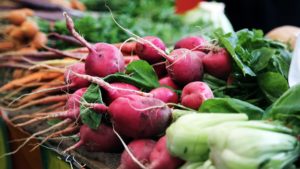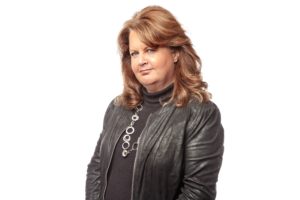Healy Group’s mission to help others and live out the Healy Spirit has led our organization to support the Food Bank of Northern Indiana in their efforts to fight hunger in our community.
To speak out against hunger during Hunger Action Month, we spoke with Food Bank of Northern Indiana Executive Director Marijo Martinec. She shared some common misconceptions people have about food banks and the actions her organization takes to fight hunger in northern Indiana.
Dispelling common misconceptions about food banks and the people they serve

Unlike grocery stores, some food pantries do not have refrigeration and cannot stock meat, dairy, fresh produce, or other perishable items.
“Going to food pantries is not like going to a grocery store,” explained Martinec. Unlike a grocery store, food banks are not stocked with enough food items to carry their patrons through the week. In fact, some food pantries do not have refrigeration, so they cannot stock meat, dairy, fresh produce, or other perishable items.
Food pantries are not open every day. In some areas, wait times to shop at a food bank can be hours. “We have a food pantry located on-site at the Food Bank and often times, clients start lining up two hours before it opens,” said Martinec. “It’s a lot of work if you are poor and you need these services.” And when it’s finally their turn to shop, there are not always items that go together easily to make a meal. “We try to encourage food bank donors to think healthy and nutritious and donate food items our patrons can use to prepare nutritious meals. ” Martinec added.
One of the biggest misconceptions is that food bank patrons do not work. According to Martinec, many do work and they often work more than one job, but still struggle financially. They run out of food before they get their next paycheck. “Our area has been slow to recover from the recession,” she explained. “When money is tight, what often gets left out of the budget is food in order to pay the rent or utilities.” the Food Bank of Northern Indiana mobilizes for donor support to fight hunger.
How the Food Bank of Northern Indiana mobilizes for donors to support the fight against hunger
In 2017, the Food Bank of Northern Indiana distributed more than 7 million pounds of food to its network of 165 member agencies in its six-county service area.
Today, nearly 13% of the residents of northern Indiana are food insecure. This breaks down to one in six adults and one in four children. “We are seeing a growing need in senior and young adult populations,” said Martinec.
“Donor support can make a big difference in the fight against hunger in our community, ” said Martinec. “For $140, a child can receive a weekend sack of food for the entire school year.”
The Food Bank of Northern Indiana has developed the following programs to fight hunger in the young and the elderly:

When children eat well, they focus better at school.
Food 4 Kids Backpack
Food 4 Kids Backpack program serves 2300 children in five counties. It discretely offers food to school-aged children to ensure they have something to eat during weekends and holiday breaks. “This is a very affordable program,” explained Martinec. “Volunteers pack the sacks while others deliver them to the participating schools.”
Healthy Choice Market
Healthy Choice Market was created to provide individuals with high-risk medical problems and little-to no-insurance a dignified, educational experience to encourage healthy food choices. By working in partnership with Saint Joseph Regional Medical Center, Memorial Hospital of South Bend and the American Culinary Federation South Bend Chefs and Cooks Association, the Healthy Choices Market serves clients who have diabetes and high blood pressure. “At the end of class, they get to take home the nutritious items the chefs used to create the meals,” said Martinec.
Senior Nutrition Program
Senior Nutrition Program helps seniors in our community with limited financial resources sustain a healthy lifestyle. Expensive medications and medical treatments can wreak havoc on seniors’ financial security. The program provides a monthly bag of food with shelf-stable items such as rice or dry beans, canned tuna or chicken, macaroni and cheese, canned vegetables, boxed potatoes, pasta and sauce, applesauce, cereal, crackers, soups, bread and one frozen meat.
Mobile Food Pantries
Mobile food pantries are hitting the road to meet the growing demand by bringing the food directly to people in need in its six-county service area. It’s stocked with fresh produce, protein items, and dairy that are not easily accessible.
Hunger Impacts Our Community
Hunger is a community health, school performance, and economic issue and it exists in every county of the United States.
We’ve all experienced what it feels like to be hungry, but it’s usually a temporary circumstance. Food is a primary need for survival. When people don’t know when they will eat their next meal, it becomes impossible to focus. As a result, work, school, and family responsibilities suffer.
Hunger is a silent epidemic. When all of our residents have food security and access to nutritious foods, we will be more physically and mentally prepared to take on life’s challenges.
September is Hunger Action Month. Pick one of these items to do this month. Small or large, your contributions fight against hunger in our community and positively impact our shared world.
About the Author

Alicia Weber, a Risk Management Advisor at the Healy Group, has over 20 years of experience in employee benefits. She actively supports her community and her profession, serving on the board of directors for the Food Bank of Northern Indiana and the Greater Northern Indiana Association of Health Underwriters. To unwind and relax, she plays golf and enjoys going to the beach. She and her husband have one son, who is in college.


Recent Comments